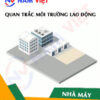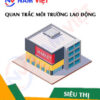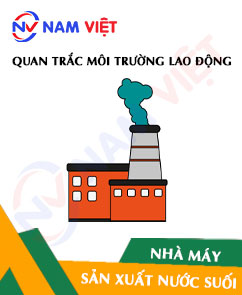Occupational environment monitoring of a fresh milk manufacturing factory
99,000 ₫
Note: The above price is calculated for one sample, and the price may fluctuate depending on the area of the environment to be monitored and market movements. For more accurate pricing support, please refer to the price list or contact our consulting staff directly.
Monitoring the environment of a fresh milk manufacturing factory is a session of collecting, analyzing, and evaluating factors at the workplace that may harm workers health.
Table of Contents
Toggle1. Overview of the Fresh Milk Manufacturing Factory
a. What is a fresh milk manufacturing factory?
A factory manufacturing fresh milk is a specialized facility for processing and packaging fresh milk. The factory receives fresh milk from suppliers such as farms or milk producers, and then processes, filters, and packages the milk into products such as plain fresh milk, sweetened fresh milk, flavored fresh milk, organic fresh milk, and various other types. The fresh milk manufacturing factory ensures compliance with food safety and quality regulations to guarantee that the milk meets quality and nutritional safety standards for consumers.

b. Production stages in a fresh milk manufacturing factory
The production stages in a fresh milk manufacturing factory may include the following steps:
- Collection and transportation of milk: Fresh milk is collected from suppliers such as farms or milk producers. The milk is then transported to the factory using specialized vehicles that ensure safety and maintain milk quality.
- Reception and inspection of milk: At the factory, fresh milk is received and undergoes quality inspections, including checking fat content, sugar, protein, bacteria, and other parameters to ensure the milk meets quality standards.
- Processing and sterilization: After inspection, fresh milk is processed to remove impurities, such as organic debris and potential chemical residues. Simultaneously, sterilization is carried out to kill bacteria and extend the milk’s shelf life.
- Filtration and cream separation: The milk is further filtered to remove fine impurities like dust, algae, and remaining bacteria. Cream separation is performed to separate the cream layer from the milk, which can then be used as skim milk or fresh cream.
- Processing and packaging: After the above processes, the milk is processed and packaged into convenient units such as bottles, cartons, pouches, or small bags. The packaging process ensures the safety and preservation of the milk for extended periods.
- Quality inspection and boxing: Before leaving the factory, milk samples are taken for final quality inspection to ensure that the products meet quality and safety standards.
- Storage and transportation: Fresh milk is stored in refrigerated warehouses to maintain appropriate temperatures for the milk.

c. Types of machinery used in fresh milk manufacturing factories
In fresh milk manufacturing factories, various machines and equipment are used to carry out production and processing stages. Some common machinery includes:
- Milk filter: This machine uses filters to remove impurities such as dust, algae, and bacteria from fresh milk.
- Sterilization machine: Uses high temperature or pressure to kill bacteria in fresh milk and extend shelf life.
- Cream separator: Used to separate the cream layer from fresh milk, producing skim milk or fresh cream.
- Packaging machine: Automatic machines are used to package milk into convenient units such as bottles, cartons, pouches, or small bags. This machine can perform tasks like pouring milk, capping, sealing, and labeling.
- Quality inspection machine: Automated machines are used to check quality parameters of fresh milk such as fat content, sugar, protein, bacteria, and other indicators.
- Cooling and storage systems: Refrigeration systems maintain appropriate temperatures for milk during storage.
- Conveyors and transport equipment: Specialized conveyors and transport devices are used to move milk from one production stage to another.

d. Occupational diseases that may affect workers in fresh milk manufacturing factories
Workers in fresh milk manufacturing factories may be at risk of certain occupational diseases due to the following factors:
- Respiratory issues: Workers may develop respiratory diseases from exposure to dust, fumes, or small particles during milk manufacturing, such as bronchitis, pneumonia, or chemical-induced pneumonia.
- Allergies: Workers may have allergic reactions to components in milk, such as milk proteins, flavorings, or bleaching agents. Allergies can cause symptoms like dermatitis, itching, swelling, or difficulty breathing.
- Bacterial infections: Occupational diseases may occur due to exposure to bacteria in the production environment, such as skin infections, inflammation, or hepatitis.
- Musculoskeletal and spinal issues: Tasks involving lifting and transporting heavy items may increase risks of spinal injuries, back pain, spinal degeneration, and other musculoskeletal problems.
- Chemical exposure: Milk manufacturing involves using bleaching agents, disinfectants, and preservatives. Prolonged exposure may lead to health issues such as skin irritation, eye inflammation, or contact dermatitis.
To prevent occupational diseases, it is necessary to follow safety regulations, properly use personal protective equipment, adhere to correct work procedures, and participate in occupational safety and industrial hygiene training courses.

e. Common types of milk in the market
There are many types of milk on the market, differing in composition, manufacturing process, and purpose of use. Some common types include:
- Fresh milk: Milk harvested from animals that has not undergone sterilization. It can be consumed directly or stored in a refrigerator for a short period.
- Cow’s milk: The most common type of milk, produced from cows, containing essential nutrients such as protein, calcium, and vitamin D.
- Soy milk: Made from soybeans and often chosen as an alternative to animal milk. Suitable for vegetarians or individuals allergic to milk.
- Almond milk: A plant-based milk made from almonds. It provides healthy fats and is commonly used in dairy-free food preparation.
- Goat and sheep milk: Milk from other animals, with distinct flavors and less common than cow’s milk, but used in certain recipes and products.
- Skimmed milk: Milk from which cream has been separated. Used in many recipes and as a main ingredient for fresh cream.
- Unsweetened milk: Milk with reduced or removed natural sugars during processing, suitable for those reducing sugar intake.

2. Overview of Occupational Environment Monitoring Services
a. What is occupational environment monitoring at a fresh milk manufacturing factory?
Occupational environment monitoring (or workplace environmental measurement) at a fresh milk manufacturing factory involves collecting, evaluating, and analyzing measurement indicators of workplace environmental factors to implement timely mitigation measures, minimize environmental hazards to workers’ health, and prevent occupational diseases. Workplace environmental monitoring is mandatory for fresh milk manufacturing factories.
Workplace monitoring plays a critical role in protecting and enhancing workers’ health, as employees are the primary resource of a company and directly generate profit. Workers exposed to risks or occupational hazards beyond permitted limits may experience health issues and develop occupational diseases.
REGISTER FOR OCCUPATIONAL ENVIRONMENT MONITORING SERVICE
b. An Toan Nam Viet’s occupational environment monitoring program
An Toan Nam Viet’s occupational environment monitoring program is developed by monitoring engineers specializing in occupational safety and environmental protection. Aimed at ensuring workers’ health and safety, the program uses modern measurement methods to monitor air quality, water, microclimate, physical factors, dust, and more within the workplace. This program is crucial in maintaining a safe working environment and protecting workers’ health.
Additionally, An Toan Nam Viet’s program plays a key role in researching and developing new solutions to improve workplace environmental quality. With the dedication and professionalism of its expert team, An Toan Nam Viet’s exclusive monitoring program has become a breakthrough in labor safety management and environmental protection in Vietnam.

c. Standardization in workplace measurement procedures
Standardization in An Toan Nam Viet’s workplace measurement procedures is vital for ensuring the quality of measurement results. To guarantee accuracy and reliability, the program follows recognized standards and procedures established by the Ho Chi Minh City Department of Health. This ensures the collected data is highly reliable for evaluating workplace conditions and making decisions to improve the work environment and protect workers’ health.
These standardized procedures also ensure that measurements are conducted by highly skilled monitoring specialists with years of experience, allowing managers and experts to trust the results from An Toan Nam Viet and make precise decisions that safeguard worker health and the environment.
By applying standardized workplace measurement procedures, An Toan Nam Viet demonstrates its commitment to ensuring a safe work environment and protecting employees’ health, while contributing to the development and enhancement of labor safety management and environmental protection in Vietnam.
d. Reporting results of monitoring at fresh milk manufacturing factories
Occupational environment monitoring results are prepared according to Form No. 04, Appendix III issued with Decree 44/2016/NĐ-CP and prepared in two copies: one copy is sent to the labor facility that contracted the monitoring service, and the other is retained by the monitoring organization.
The retention period for occupational environment monitoring results is unlimited, in accordance with legal regulations.

e. Frequency of occupational environment monitoring according to the law
According to Clause 2 of Article 18 of the Law on Occupational Safety and Hygiene 84/2015/QH13, employers must organize workplace environment monitoring to assess harmful factors at least once a year.
f. Deadline for submitting occupational environment monitoring reports according to the law
The deadline for submitting the report is before December 31 each year. Enterprises at manufacturing facilities are required to submit occupational environment monitoring results to the Department of Health at the locality where the business has its headquarters and where workers are employed.
Whenever there are changes in technology or manufacturing processes, or when renovating or upgrading facilities that may introduce new harmful factors to workers’ health, enterprises must update labor hygiene records related to harmful factors that require occupational environment monitoring.
g. Penalties for violations of occupational environment monitoring by employers
According to Article 27 of Decree No. 12/2022/NĐ-CP dated January 17, 2022, regulating administrative penalties in labor, social insurance, and Vietnamese workers working abroad under contracts:
- Clause 2: A fine of 2,000,000 – 5,000,000 VND applies to employers who fail to publicly disclose to employees at the monitored workplace and management locations the results of occupational environment monitoring and hazard assessments immediately after results are available.
- Clause 3: A fine of 20,000,000 – 40,000,000 VND applies to employers who do not conduct occupational environment monitoring to control health hazards for workers as required by law.
- Clause 4: A fine of 40,000,000 – 60,000,000 VND applies to employers who collude with monitoring organizations to commit fraud in occupational environment monitoring activities, but not to the extent of criminal liability.
3. Harmful Environmental Factors for Workers in Fresh Milk Factories
Workers in fresh milk factories may be exposed to several harmful environmental factors. The main factors include:
- Milk vapor: During fresh milk production, milk vapor can irritate the respiratory tract and cause difficulty breathing for workers. Prolonged inhalation of milk vapor may lead to pneumonia, bronchitis, and other respiratory issues.
- Chemicals: In cleaning and equipment processing, fresh milk factories use cleaning agents and other chemicals. Long-term exposure to these chemicals can cause skin irritation, dermatitis, eye inflammation, and other health problems.
- Noise: In some production processes, such as milk grinding and mixing, noise levels may exceed permissible limits. Continuous loud noise can cause hearing issues, stress, and negatively affect overall worker health.
- Temperature and humidity: Some areas in fresh milk factories may have high temperature and humidity, especially in milk storage and processing rooms. These conditions can cause discomfort and affect workers’ health and comfort.
- Hygiene: Fresh milk factories must comply with strict hygiene regulations to ensure food safety. However, working in unhygienic environments may pose risks of foodborne diseases such as diarrhea, enteritis, and infections.
REGISTER FOR WORKPLACE ENVIRONMENT MONITORING SERVICE
4. Measures to Improve Working Conditions in Fresh Milk Factories
To improve working conditions in fresh milk factories and ensure workers’ health, the following measures can be applied:
- Ensure hygiene during production: Implement strict hygiene procedures to maintain cleanliness and food safety. Ensure personal hygiene, equipment hygiene, and clean work surfaces.
- Adjust and control temperature: Ensure that work areas have comfortable and suitable temperatures. Adjust air conditioning systems and provide adequate ventilation to reduce the risk of overheating or overcooling.
- Waste management: Ensure proper management of fresh milk production waste to avoid environmental pollution and health risks. Treat and recycle waste according to regulatory requirements.
- Reduce noise: Apply measures to minimize noise in the factory, such as using noise-reduction equipment, performing regular maintenance on machinery, and implementing safety measures to reduce noise.
- Training and guidance: Provide training and guidance for workers on safe work procedures, hygiene, and personal protective measures. Create a working environment that enhances awareness and compliance with safety rules.
- Provide personal protective equipment (PPE): Ensure adequate and correct supply of PPE such as masks, safety glasses, gloves, protective clothing, and safety shoes to protect workers’ health while working in fresh milk production environments.
- Periodically conduct workplace environment monitoring in factories, collect and analyze harmful factors affecting workers, and adjust measures to reduce risks and prevent occupational diseases.
5. Benefits of Periodic Monitoring in Fresh Milk Factories
An Toan Nam Viet provides businesses with excellent benefits when using workplace environment monitoring services in accordance with Decree 44/2016/ND-CP on managing and controlling harmful factors in working environments affecting employees.
- Businesses can proactively control harmful factors in their workshops or factories.
- Receive recommendations on measures to reduce harmful factors and improve the working environment.
- Indirectly protect human resources, the key factor in enterprise development.
- Reduce the impact of occupational diseases on human health, thereby lowering future treatment costs.
- Healthier workers lead to higher product quality and consistent production output.
- Comply with labor safety regulations and avoid legal risks.
- Enhance professionalism and reputation, elevating the enterprise’s brand.
Nam Viet’s environmental monitoring service is a solution to minimize occupational disease risks, contributing to a clean and high-quality working environment.

6. Nationwide Workplace Environment Monitoring Center
Nam Viet Workplace Environment Monitoring Center is a professional unit specializing in monitoring and measuring workplace environmental quality throughout all provinces of Vietnam. With an experienced team of monitoring specialists, the center uses modern measuring equipment to ensure accuracy and reliability.
In addition to monitoring services, the center assists clients in planning, handling, and tracking workplace environmental issues. Following the motto “customer-centric,” the center prioritizes client satisfaction, meets all client needs, and provides the best solutions for businesses.
REGISTER FOR WORKPLACE ENVIRONMENT MONITORING SERVICE
With investment in technology, equipment, and personnel, Nam Viet’s monitoring center has become a reputable unit in workplace environment monitoring in Ho Chi Minh City, with objectives including:
- We always prioritize brand reputation and service quality.
- We provide clients with the best and most suitable solutions.
- Alongside a team of experienced Masters and Engineers committed to environmental protection and business benefits.
- By working with Nam Viet Environmental Monitoring, companies receive professional service from experts in the field and the best cost advantages.
The workplace environment monitoring process at Nam Viet includes:
- Before monitoring, all machinery and equipment are calibrated according to legal regulations.
- Implement the complete monitoring process as committed to the Department of Health.
- Report monitoring results honestly to employers.
- If results indicate unsafe conditions, Nam Viet will provide solutions, and the enterprise will implement:
- Measures to improve working conditions, minimize harmful factor impacts, and prevent occupational diseases.
- Health check-ups to detect occupational and work-related diseases early for employees in unsafe environments.
- Provide in-kind benefits to employees according to labor laws.

7. Workplace Environment Monitoring Service Price List
To help businesses perform workplace environment monitoring professionally and effectively, Nam Viet provides clients with a quality and reasonably priced service price list.
- Our price list provides detailed information on the costs of monitoring services we offer, including transportation, measurement, analysis, and reporting. Clients can trust the accuracy and reliability of our monitoring reports.
- We commit to offering the most competitive and reasonable prices in the market and are always ready to answer questions about monitoring services quickly and professionally.
- With Nam Viet’s price list, clients can easily choose service packages that meet their needs. We are committed to delivering the highest satisfaction with professional service quality.
No comments yet












Review Occupational environment monitoring of a fresh milk manufacturing factory
There are no reviews yet.